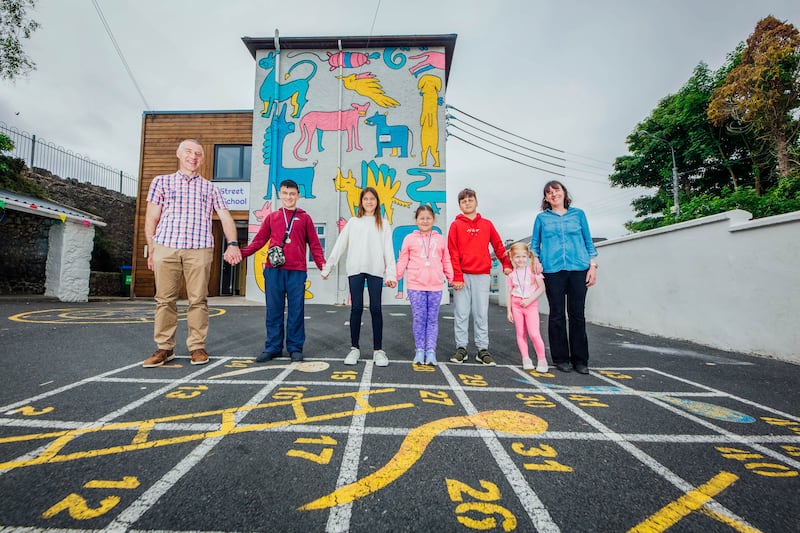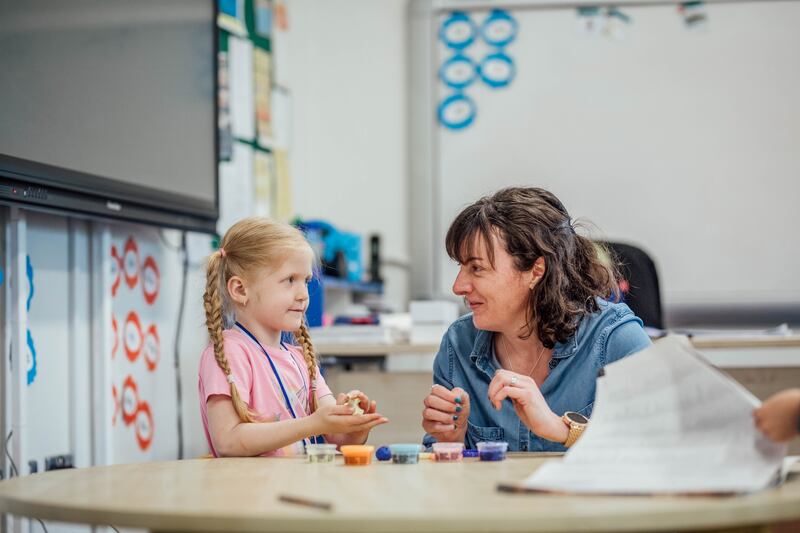On February 24th last, Olha Mahdyk was busy teaching students in her hometown of Irpin on the outskirts of the Ukrainian capital Kyiv.
She woke the following morning to the boom of explosions nearby.
“I was lying in my bed thinking, ‘the war has started’, but was too afraid to check my phone for the news. I lay there for half an hour, afraid to move.”
The school – partially destroyed by bombing – was shut immediately and its 2,000 students were scattered across Europe.
Shortly afterwards, Mahdyk fled with her 14-year-old son, leaving her husband behind. The idea of finding a teaching job, not to mind a safe place to live, seemed remote. But today she is teaching and supporting Ukrainian pupils at St Joseph’s Primary School in Tipperary town.
“Honestly, I didn’t dream that I would be able to teach again so soon,” she says. “Normally you have to have the right qualifications and go through lots of stages to teach in another country.
“But when I approached some schools locally, to say I was available to help teach English, I was hired straight away.”
The speed at which the Irish education system has responded to meet the needs of Ukrainian pupils has impressed not just newcomers, but seasoned classroom professionals.
Teachers and principals say the process of accessing additional teachers, which often takes months, is getting approval from the Department of Education within hours.
“The speed of the response has been very good,” says Pairic Clerkin of the Irish Primary Principals’ Network (IPPN). “One school principal told me it took 19 minutes to access an extra teaching resource, which is great. Yet it can take 19 months to get a special needs assistant.”
Latest figures show almost 7,000 Ukrainian pupils have been enrolled in schools across Ireland, the majority in primary schools.
To assist with the transition of refugees into Irish schools, the 16 education and training boards across the State are hosting one-stop shops, or “regional education and language teams”, to help Ukrainian families source school places and advise the department on additional teaching resources required.
At St Joseph’s Primary School, which has four Ukrainian pupils, principal Louise Tobin says the benefit of having a teacher who can also speak Ukrainian and understand what vulnerable students are going through is invaluable.
“It’s been huge in settling them in and engaging them. It makes them feel at ease, it scaffolds their learning and ensures they’re in a good place when they come in the morning,” says Tobin, deputy president of the IPPN.
![Ukrainian teacher Olha Mahdyk who is teaching in St Joseph's Primary School, Tipperary town, with students from Ukraine, Sofia and Diana Kucherak [seated], Vasilisa Kichka and Oksana Semenova. Photograph: John D Kelly](https://www.irishtimes.com/resizer/v2/OCARHV3AH5F6HJFQPWWRGMKAEE.jpg?auth=8f60cbe9a3674b31f87256ed29505af941f4d5f07d1081fc5ef3563906bfb9c6&width=800&height=533)
Tobin says more support would be helpful – the school gets just five hours extra teaching time a week – especially for the two older girls in sixth class.
“They have a greater sense of trauma, they’ve lost their homes . . . but Neps [the National Educational Psychological Services] has been very helpful in dealing with concerns over the older children.”
In some cases, the arrival of Ukrainian pupils has transformed the face of small schools.
At Church Street National School in Rathkeale, Co Limerick, eight Ukrainian children have boosted pupil numbers in the two-teacher school by 25 per cent.
“Our numbers here are small, so there has been huge excitement to have so many new children starting here,” says school principal Niall West. “The new children are just very happy to be here; they’ve settled in very well.”
The school gets 10 hours of additional teaching time a week. The learning, he says, is a two-way process: Ukrainian pupils are learning English, while Irish pupils are picking up Ukrainian.

For Ukrainian family members, the school has become the centre of their new community. Dozens recently attended a recent event where the school – founded in 1873 – relaunched with a new name (it was formerly known as Rathkeale No 2 National School).
“What was lovely was that the parents told us that their children were so happy here and fond of the teachers,” he says.
As students settle in, teachers are beginning to notice some of the differences between school in Ukraine and Ireland.
Most agree the system in Ukraine is stricter, with a greater focus on more traditional learning styles and discipline in the classroom.
“We’ve really noticed how happy they are to be here and experience the fun side of things,” says West. “We had a sports day, with water games, which turned into a water fight between the pupils and teachers. You should have seen the look of joy on their faces when they realised they were allowed to throw a wet sponge at a teacher!”
Ukrainian pupils also seem, on balance, to be stronger at maths and display a mastery of numbers that puts them in advance of where Irish students are, several teachers say.
“Our teachers do certainly say they are very, very strong at maths and science. We’ve see that,” says Tobin.
West agrees: “Maths is strong – and some of the methods they use are very different in areas like long division, for example.”

On the downside, Mahdyk says, Ukrainian schools are saddled with large class sizes – often up to 40 pupils – and a system that can heap pressure on the shoulders of students at an early age.
“We’re in the process of changing the education system to make it less stressful with less pressure... I notice here that children are happier to attend school. They know they will be met a smile and teachers are very kind to them. There’s no pressure and no shouting, but classes are still well behaved.”
She also praises the Irish system’s emphasis on subject choice at second level; in Ukraine, she says, subjects such as science and biology are often mandatory.
At second level, schools also have good news to report on how students are settling in, though their needs can be more complex.
Trinity Comprehensive School in Ballymun was one of the first to enrol Ukrainian pupils. Principal Frances Neary says transition year (TY), in particular, has helped new arrivals to adjust and make connections in the wider community.
“It made sense for many of the pupils to go into TY because there isn’t academic pressure and we could focus on the students developing positive relationships with their peers. It’s worked out really well,” she says.
The school has a buddy system that helps to immerse new students in school life, while it has an extensive learning support team that is providing English language tuition to the new arrivals.
Among the few grumbles from schools when it comes to the State’s response to new arrivals from Ukraine are decisions by housing authorities to move families to different areas after they have put down roots in a school.
Some schools also complain that the speedy response to Ukrainian arrivals highlights a “two-tier” system that is less responsive to the needs of other refugees. Education officials say these issues are being worked out.
As happy as many Ukrainian students are in the Irish system, Mahdyk says all students ultimately want to return home sooner rather than later. She continues to teach some of her pupils in Irpin online.
“We all hope that one day we can return to live in a peaceful, independent country,” she says. “We all want to come home to help rebuild our society. I think our society will be ever more united. We all want the same – to live in peace.”



















